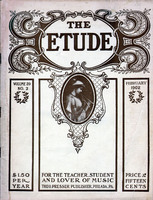BY FREDERIC NIECKS.
Unless we know the time and other circumstances of the application, the term “sonata” tells us no more than that the thing signified is an instrumental composition (sonata, from sonare, to sound, in the sense of “to play on an instrument”). It leaves untold what are the formal and substantial characteristics of the composition, and whether the latter is intended for one, two, several, or many instruments. Already in the sixteenth century the two Gabrielis wrote sonatas varying in form and for varying numbers of bow and wind instruments, most of which may be styled orchestral compositions. For introductory, intermediary, and concluding instrumental pieces and strains in vocal works, the word “sonata” was used synonymously with “sinfonia,” not only in early times, but still in the eighteenth century.
The sonata of several movements and for several bow instruments, or for a solo violin and a thoroughbass accompaniment, began to be developed in the seventeenth century, and attained its full bloom in the eighteenth, Corelli and Tartini being the most famous names called up in this connection. Johann Kuhnau, J. S. Bach’s predecessor at Leipzig, transplanted, toward the end of the seventeenth century, the sonata for violins to the clavier. “Why should not such things,” the author asked, “be attempted on the clavier, as well as on other instruments?” The cultivation of the clavier and violin sonata, which must be distinguished from that of the violin sonata with a mere thorough-bass executed on the clavier, may be dated from J. S. Bach. The modern clavier sonata came into existence about the middle of the eighteenth century, and with it, soon after, the modern clavier and violin sonata. Among the most prominent of those who took part in the slow and complicated development of the modern sonata form, Domenico Scarlatti, with his one-movement sonatas, and C. P. E. Bach, with his sonatas of more movements, deserve more especially to be mentioned.
A summary description of the modern sonata since the Haydn-Mozart period might be worded as follows: A composition for the pianoforte, or for the pianoforte and one other instrument, oftenest consisting of three movements, sometimes of four, and now and then of two, at least one of them in what has been called first-movement sonata form.



